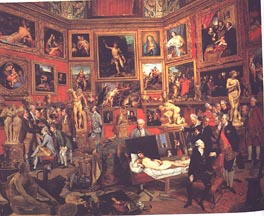

Zoffany's The Tribune of the Uffizi, as we discussed earlier, epitomises the eighteenth century ideas of the connoisseur and of the masterpiece. These English gentlemen have come to Italy expressly to study these monuments of art extending from Antiquity to their present world. Their reverence for these reflects an assumption that these works have transhistorical value. These great works are part of a body of works that are understood to form a canon of art. The selection of works extending back to Greek and even Egyptian antiquity calls to attention the authority of the Western cultural tradition. The connoisseurs also show reverence to the creators of these works, who are understood to be "men" of genius. The English gentlemen identify themselves as direct inheritors of this cult of great "men." As men of discrimination, these English connoisseurs understand themselves to be the arbiters of Truth and Beauty.
The authority of this Western Tradition and the reverence for canons of great works or masterpieces, whether they are artistic, literary, musical, dramatic, etc., have become institutionalized in our museums, concert halls, libraries, theaters, publishing houses, university curricula. As Griselda Pollock has recently written (Differencing the Canon, p. 4): 'We know these canons --Renaissance, modernist, etc. through what gets hung in art galleries, played in concerts, published and taught as literature or art history in universities and schools, gets put on the curriculum as the standard and necessary topics for study at all levels of the educating --acculturating, assimilating-- process."
This is exactly the structure of the traditional art history course and the text that accompanies it. Emphasis is placed on the chronological development of the Western artistic tradition, and students are introduced to what are understood to be the masterpieces by the great artists of this tradition. The authority of the individual work is justified by its relationship to other great works and the creator's originality to transcend "his" inheritance. Pollock (Differencing the Canon, p. 5) notes "how canons actively create a patrilineal genealogy of father-son succession and replicate patriarchal mythologies of exclusively masculine creativity."
Such disciplinary practice seems natural and self-evident. For an art historian trained in traditional practices of the discipline, it is hard to imagine an alternative structure. This blindness can be attributed to the fact that this traditional art historian has been trained within disciplinary practices formed by western art.
The texts that follow have been excerpted from several of the standard surveys of Art History.
Gardner's Art Through the Ages, Horst de la Croix, Richard G. Tansey, Diane Kirkpatrick, 9th edition, 1991.
Frederick Hartt, Art, 3rd edition, 1989.
H.W. Janson, History of Art, 5th edition, revised and expanded by Anthony F. Janson, 1995.
The passages illustrate the traditional art historical analysis of a group of canonical works. Notice how the rhetorical strategies employed by these scholars reinforce the authority of the Western tradition, justify the inclusion of the particular works into the canon of art history, and testify to the individual artists' place in this tradition and claim to originality. The texts illustrate Pollock's point about the patrilineal genealogy of the history of art and the assumption that creativity is exclusively masculine.
In reading these texts, I hope you pay attention to what is not said as much as what is said. I have intentionally included many of these works because of their focus on rape or abduction. Pay attention to how the artists and art historians respectively approach this issue. You might consider how rape is treated in our own culture whether it be the sensational legal cases (William Kennedy Smith) or popular entertainment (The General's Daughter).
Feminism and other contemporary critical perspectives have offered us alternative visions that make us aware of the limitations and dangers of the traditional perspectives. Margaret Carroll in an article entitled "The Erotics of Absolutism" has presented an alternative, feminist reading of many of these same images. Judge the difference between these readings. As Carroll notes in her article, there is a significant parallel between the development of ideas of nationalism in Early Modern Europe and the proliferation of this rape imagery. A dramatic demonstration of the tragic continuity of rape at the service of nationalism has been brought out in horrifying accounts of Serbian soldiers publicly raping Muslim women during the Balkan Wars. There is a recent book by Slavenka Drakulic entitled S.: A Novel about the Balkans. Just as rape has been used as a tool of nationalist causes, there has been the regular practice of plundering art by conquering armies. For example, German looting of art during the World War II has been seen as a form of rape. A book by Lynn Nicholas which focuses on the fate of Europe's art treasures under the Third Reich was entitled The Rape of Europa.
Frederick Hartt, History of Italian Renaissance Art , pp. 499-500:
Discussion of Michelangelo's Creation of Adam from the
Sistine Ceiling.

Of all the images that crowd the immense complex of the ceiling, the Creation of Adam is the one that has most deeply impressed posterity. Here we are given a single, overwhelming vision of the sublimity of God and the potential nobility of man, unprecedented and unrivaled in the entire history of visual art. Borne aloft in his wide-floating mantle bursting with the forms of wingless angels, the Lord moves before us, his calm gaze accompanying and reinforcing the movement of his mighty arm. He extends his forefinger, about to touch that of Adam, whose name means "Earth," and who reclines on the barren coast of earth, barely able as yet to lift his hand. The divine form is convex, explosive, paternal; the human is concave, receptive, and conspicuously impotent. All the pomp and splendor of customary depictions of the Almighty have vanished. The Lord is garbed only in a short tunic, which reveals the power of his body and limbs. Even Michelangelo's precise depiction of muscles, veins, wrinkles, fingernails, and gray hair does not reduce the universality of this celestial apparition, which radiates a power so immense as to seem a fitting embodiment of such a modern idea as cosmic energy. Love and longing stream from the silent face of Adam toward the Omnipotent, who is about to give him life and strength. In the breadth and nobility of the proportions, in the pulsation of the forms and the flow of their contours, above all in the intensity of feeling that moves through every plane, Adam is one of the most beautiful human figures ever imagined. A century of Early Renaissance research into the nature and possibilities of human anatomy seems in retrospect to lead to this single, unrecapturable moment, in which all the pride of pagan antiquity in the glory of the body, all the yearning of Christianity for the spirit have reached a mysterious and perfect harmony.
Hartt, p. 615: Michelangelo's vision of a new and grander humanity
reaches its supreme embodiment in the Creation of Adam. Instead
of standing on earth as in all earlier creation scenes, the Lord
floats through the heavens and is enveloped in the violet mantle
he wears in all the scenes in which he appears. It is noted here
for the first time that this violet color conforms to that required
for the vestments of the clergy during Advent and Lent, the penitential
periods before the coming of Christ at Christmas and his resurrection
at Easter. The Lord is borne aloft by wingless angels; with only
a single youthful exception, all of Michelangelo's angels are
wingless, as if he could not tolerate violation/ p. 615 of the
beauty of the human body by an attachment from any other form
of life. Michelangelo's Creator for the first time makes believable
the concept of omnipotence. A dynamo of creative energy, God stretches
forth his hand, about to touch with his finger the extended finger
of Adam. It was shown by the late Charles Seymour that this image
of the creative finger derives from the famous medieval hymn "Veni
Creator Spiritus" ("Come, Creator Spirit") sung
at Pentecost, the festival of the Descent of the Holy Spirit,
but also at conclaves in the Sistine Chapel, before the afternoon
scrutiny for the election of a new pope. In this hymn the "finger
of the paternal right hand" is invoked to bring speech to
our lips, light to our senses, love to our hearts, and strength
to our bodies. Adam reclines on the barren ground below, longing
for the life and love about to be instilled by this finger. As
we have seen in the discussion of Jacopo della Quercia, Adam
means "Earth," and the figure is shown not as in Jacopo's
relief, merely astonished at the appearance of the Lord, but ready
to be charged with the energy that will lift him from the dust
and make of him a "living soul" (Genesis 2:7).
Adam's body is probably the most nearly perfect Michelangelo ever
created, a structure embodying all the beauty of Classical antiquity
and all the spirituality of Christianity. As in all High Renaissance
compositions, the action in this one --based on the mirroring
of the convex curve of the fecundating Creator in the concave
curve of the receptive creature-- will vanish in seconds, and
yet it is preserved forever....
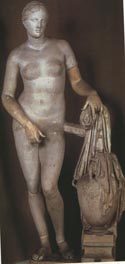
|
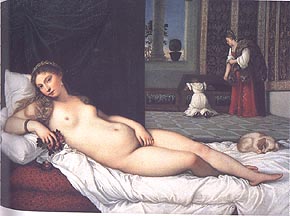
|
|
|
|
Gardner, pp. 685-6: As Praxiteles brought the motif of the
feminine nude into ancient Greek art, so Giorgione and Titian
re-create it for the art of the modern West. In 1538, at the height
of his powers, Titian painted for the Duke of Urbino the Venus
of Urbino which gives us the compositional essentials for the
representation of a theme that will be popular for centuries.
His version, based on an earlier and pioneering one painted by
Giorgione, was to become official for paintings of the reclining
nude, no matter how many variations would ensue. Venus reclines
on a gentle slope made by her luxurious, pillowed couch, the linear
play of the draperies contrasting with the sleek, continuous volume
of her body. At her feet is a pendant (balancing) figure --in
this case, a slumbering lapdog. Behind her, a simple drape serves
both to place her figure emphatically in the foreground and to
press a vista into the background at the right half of the picture....
All of the resources of pictorial representation are in Titian's
hands, and he uses them here to create original and exquisite
effects.
Deep Venetian reds set off against the pale, neutral whites of
the linen and the warm ivory-gold of the flesh are echoed in the
red tones of the matron's skirt, the muted reds of the tapestries,
and the neutral whites of the matron's sleeves and the gown of
the kneeling girl. One must study the picture carefully to realize
what subtlety of color planning is responsible, for example, for
the placing of the two deep reds (in the foreground cushions and
in the background skirt) that function so importantly in the composition
as a gauge of distance and as terminals of an implied diagonal
opposed to the real one of the reclining figure. Here, color is
used not simply for the tinting of preexisting forms but as a
means of organization that determines the placement of forms.
Titian could paint a Virgin Mary or a nude Venus with equal zeal.
Neither he nor the connoisseurs of his time were aware of the
contradiction. Yet it is significant that the female nude reappears
in Western art as Venus, the great goddess of the ancient world,
whom Medieval Christianity had especially feared and whom it damned
in exalting virginity and chastity as virtues. Now Venus returns,
and the great Venetian paintings of her almost constitute pagan
altarpieces. The Venetian Renaissance resurrects a formidable
competitor for the saints.
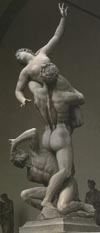
|
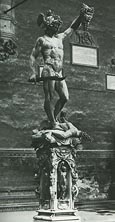
|
|
|
|
Hartt,p. 642: Although the identity of the subject mattered little to him, he [Giovanni Bologna] eventually decided on the Rape of the Sabine Woman as the title for his colossal marble group set in 1583 in the Loggia dei Lanzi, near Cellini's Perseus [and Medusa]. In contrast to all earlier statues, which concentrate on a principal view to which all others are subordinated, Bologna's composition sends us constantly around the group from one view to the next; as all the figures are engaged in the spiral movement, it is impossible to choose a principal view. The way arms and legs fly off into space was, of course, a violation of everything for which Michelangelo stood, but also a dazzling display of Bologna's skill in handling marble.
Janson, p. 520: ...Jean de Bologne (1529-1608), a gifted young sculptor from Douai in northern France, ...went to Italy about 1555 for further training. He stayed and became, under the Italianized name of Giovanni Bologna, the most important sculptor in Florence during the last third of the century. His over-lifesize marble group, The Rape of the Sabine Woman, won particular acclaim, and still has its place of honor near the Palazzo Vecchio.
The subject, drawn from the legends of ancient Rome, seems an odd choice for statuary. The city's founders, an adventurous band of men from the across the sea, so the story goes, tried vainly to find wives among their neighbors, the Sabines, and resorted at last to a trick. Having invited the entire Sabine tribe into Rome for a peaceful festival, they fell upon them with arms, took the women away by force, and thus ensured the future of their race. Actually, the artist designed the group with no specific subject in mind, to silence those critics who doubted his ability as a monumental sculptor in marble. He selected what seemed to him the most difficult feat, three figures of contrasting character united in a common action. Their identities were disputed among the learned connoisseurs of the day, who finally settled on The Rape of the Sabine Woman as the most suitable title.
Here, then, is another artist who is noncommittal about subject matter, although his unconcern had a different motive from Veronese's. Like Cellini's, Bologna's purpose was virtuouso display. His self-imposed task was to carve in marble, on a massive scale, a sculptural composition that was to be seen not from one but from all sides; this had hitherto been attempted only in bronze and on a much smaller scale. He has solved this purely formal problem, but at the cost of insulating his group from the world of human experience. These figures, spiraling upward as if confined inside a tall, narrow cylinder, perform their well-rehearsed choreographic exercise with ease; yet, like much Hellenistic sculpture, it is ultimately devoid of emothional meaning. We admire their discipline but we find no trace of genuine pathos.
Gardner, pp. 672-673: Although Giovanni's quality and importance have not always been recognized, he is the most important sculptor in Italy after Michelangelo and his work provides the stylistic link between the sculpture of that great master and that of the Baroque sculptor Gianlorenzo Bernini. Giovanni's Rape of the Sabine Women wonderfully exemplifes the Mannerist formulas of representation.
The title was given to the group after it was raised (Giovanni probably intended to present only an interesting figure composition involving an old man, a young man, and a woman). The story, derived from mythic Roman history, tells how the Romans took wives for themselves from the neighboring Sabines. The amateurs, critics, and scholars who flocked around works of art in this age of Mannerism, naming groups in any way they found appropriate, serve to indicate how important and how valued the visual arts had become. The artist himself is learned in his artistic sources; here, Giovanni twice adapts the Laocoön discovered early in the century -- once in the figure of the crouching old man and again in the gesture of the woman with one arm flung up. The three bodies interlock on an axis, along which a spiral movement runs; significantly, the figures do not break out of this vortex but remain as if contained within a cylinder. The viewer must walk around the sculpture to appreciate that, despite its confinement, the aspect of the group changes radically according to the point from which it is viewed. One reason is that the open spaces that pass through through the masses have as great an effect as the solids. This sculpture is the first large-scale group composed to be seen from multiple points of view, but, as yet, the figures do not reach freely out into space and relate to the environment. The fact that they remain "enclosed" prevents our calling them Baroque. Yet the Michelangelesque potential for action and the athletic flexibility of the figures are there. The Baroque period will see sculptured figures released into full action.

|
|
|
p. 651: Like so many of the artist's [Titian's] later works, the Rape of Europa was probably painted off and on during several years, in this case about 1559-62. The white bull, one of the many disguises of Jupiter, carries the distraught yet yielding Europa, in one of the most beautiful poses of Renaissance art, combining surprise, abandon, and unconscious grace, over a glittering blue-green and foam-flecked sea. Cupid floats on a dolphin, and a glittering golden fish surfaces below.
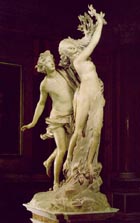
|

|
|
|
|
p. 699: An even more transient moment of climatic action, perception, and feeling is represented by the companion work for Cardinal Borghese, the Apollo and Daphne, started the year before the David and finished two years later. Bernini has seized on the second in which the panting god, in hot pursuit of the chaste Daphne (Ovid, Metamorphoses I :450-567), is foiled when she calls on her father, the river-god Peneus, for rescue and is transformed into a laurel tree. The toes of her left foot have already taken root, bark has shot up around her left leg and started to enclose her waist, her fingers and her hair are already turning into leaves and twigs, but the change is so sudden that the expression of terror has not yet left her face nor that of desire the Classical features of Apollo. The fidelity with which the softness of female flesh; the lithe body of Apollo; the textures of hair, bark, and leaves are rendered is no more dazzling than Bernini's craftsmanship in carving the scores of minute and slender projections from fragile marble. He has reached in his mid-twenties the height of his ability at pictorial sculpture -- the negation of everything Michelangelo stood for.... Evanescent effects of melting texture, translucency, and sparkle so dissolve the group into the surrounding space that it is as if Bernini had been able to carve light and air as well as marble.
[Cardinal Borghese also commissioned Bernini to do an image of Pluto and Persephone to be a companion to the David, and Apollo and Daphne:
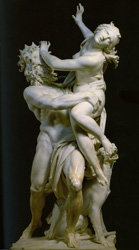
|
|
|
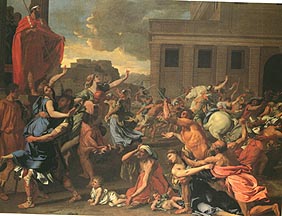
|
|
|
p. 713: At another point Poussin expounded his theory of the modes of painting by analogy with the modes or scales in Greek music, and mentioned five, the Dorian, the Phrygian, the Lydian, the Hypolydian, and the Ionic. He really did carry his ideas of the modes systematically into execution. His Rape of the Sabines [Fig. 6], of about 1636-37, exemplifies the Phrygian mode adapted to "frightful wars"; nonetheless, its "modulations are more subtle than other modes," Plato and Aristotle "held in high esteem this vehement, furious, and highly severe Mode, that astonishes the spectator." The subject is lofty, for the abduction of the Sabine women by the bachelor Romans assured the perpetuation of the Roman race; the conception is powerful; the composition effortless and natural for all its references to ancient and Renaissance statuary figures and groups; and the style beyond all praise.... The composition is staged in a limited space, flanked on one side by the temple portico in which Romulus stands and limited at the rear by a structure whose appearance is reconstructed from Vitruvius's description of a basilica. The building in the landscape in the background recalls the hill fortress of Annibale Carracci's Landscape with the Flight into Egypt. The rhythm surges along with the driving energy of a fugue by Bach or Handel, every melody of torso or limb distinguishable and perfectly modeled. Although the result may seem artificial, accepted on Poussin's own intellectual premises the painting is brilliantly effective. And, perhaps in spite of Poussin, the grand sweep of forms and colors has an undefinable something that we can call Baroque.
Janson, pp. 590-92: The Rape of the Sabine Women epitomizes the severe discipline of Poussin's intellectual style, which developed in response to what he regarded as the excesses of the High Baroque. The strongly modeled figures are "frozen in action" like statues; amny are, in fact, derived from Hellenistic sculpture. Poussin has placed them before reconstructions of Roman architeture that he believed to be archaeologically correct. The composition has an air of theatricality, and with good reason. It was worked out by moving clay figurines around a miniature stagelike setting until it looked right to the artist. Emotion is abundantly displayed, but it is so lacking in spontaneity that it fails to touch us. The attitude reflected here is clearly Raphael's. More precisely, it is Raphael as filtered through Annibale Carracci and his school. The Venetian qualities that asserted themselves early in his career have been consciously supressed.
Poussin now strikes us as an artist who knew his own mind only too well, an impression confirmed by the numerous letters in which he expounded his views to friends and patrons. The highest aim of painting, he believed, is to represent noble and serious human actions. This is true even in The Rape of the Sabine Women, which, ironically, was admired as an act of patriotism that insured the future of Rome. (According to the accounts of Livy and Plutarch, the Sabines otherwise escaped unharmed, and the young women abducted as wives by the Romans later became peacemakers between the two sides.) Be that as it may, such actions must be shown in a logical and orderly way --not as they really happened, but as they would have happened if nature were perfect. To this end, art must strive for the general and typical. In appealing to the mind rather than the senses, the painter should suppress such incidentals as color, and stress form and composition. In a good picture, the beholder must be able to "read" the exact emotions of each figure and relate them to the story. These ideas were not new. We recall Horace's dictum ut pictura poesis and Leonardo's statement that the highest aim of painting is to depict "the intention's of man's soul." Before Poussin, however, no one made the analogy between painting and literature so close, nor put it into practice so single-mindedly. His method accounts for the cold and over-explicit rhetoric in The Rape of the Sabine Women, which makes the picture seem so remote, much as we may admire its rigor.
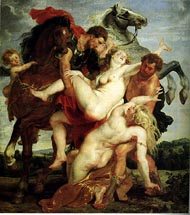
|
|
|
p. 723:[Rubens's] Rape of the Daughters of Leucippus [Fig. 7], of about 1616-17, recalls forcibly Titian's Rape of Europa, which Rubens carefully copied while in Spain. Although the figures have been made to fit into Rubens's mounting spiral, such is the buoyancy of the composition that the result does not seem artificial. The act of love by which Castor and Pollux, sons of Jupiter, uplift the mortal maidens from the ground draws the spectator upward in a mood of rapture not unrelated to that Bernini was soon to achieve in the Ecstasy of St. Theresa. The female types, even more abundant than those of Titian, are traversed by a steady stream of energy, and the material weight of all the figures is lightened by innumerable fluctuations of color running through their pearly skin, the tanned flesh of the men, the armor, the horses, even the floods of golden hair. The low horizon increases the effect of a heavenly ascension, natural enough, since this painting ... constitutes a triumph of divine love; the very landscape heaves and flows in response to the excitement of the event.
Gardner, pp. 781-782: ...Rubens has one general theme --the human body, draped or undraped, male or female, freely acting or free to act in an environment of physical forces and other interacting bodies. Rubens's conception of the human scene does not contain profoundly tragic elements nor anything manneristically intellectual, enigmatic, or complex. His forte is the strong animal body described in the joyful, exuberant motion natural to it. His Rape of the Daughters of Leucippus describes the abduction of two young mortals by the gods Castor and Pollux, who have fallen in love with them. The amorous theme permits departures from realism, especially in the representation of movement and exerted strength. The gods do not labor at the task of sweeping up the massive maidens --descendants of the opulent Venuses of Giorgione and Titian-- nor do the maidens energetically resist. The figures are part of a highly dynamic, slowly revolving composition that seems to turn on an axis; they form a diamond-shaped group that defies stability amd the logic of statics. The surface pattern, organized by intersecting diagonals and verticals, consists of areas of rich, contrasting textures: the soft luminous flesh of the women, the bronzed tan of the muscular men, lustrous satins, glinting armor, and the taut, shimmering hides of the horses. All around this surface pattern, a tight massing of volumes moves in space. The solid forms are no longer described simply in terms of the dark-light values of Florentine draftsmanship but are now built up in color and defined by light, as in Venetian painting.